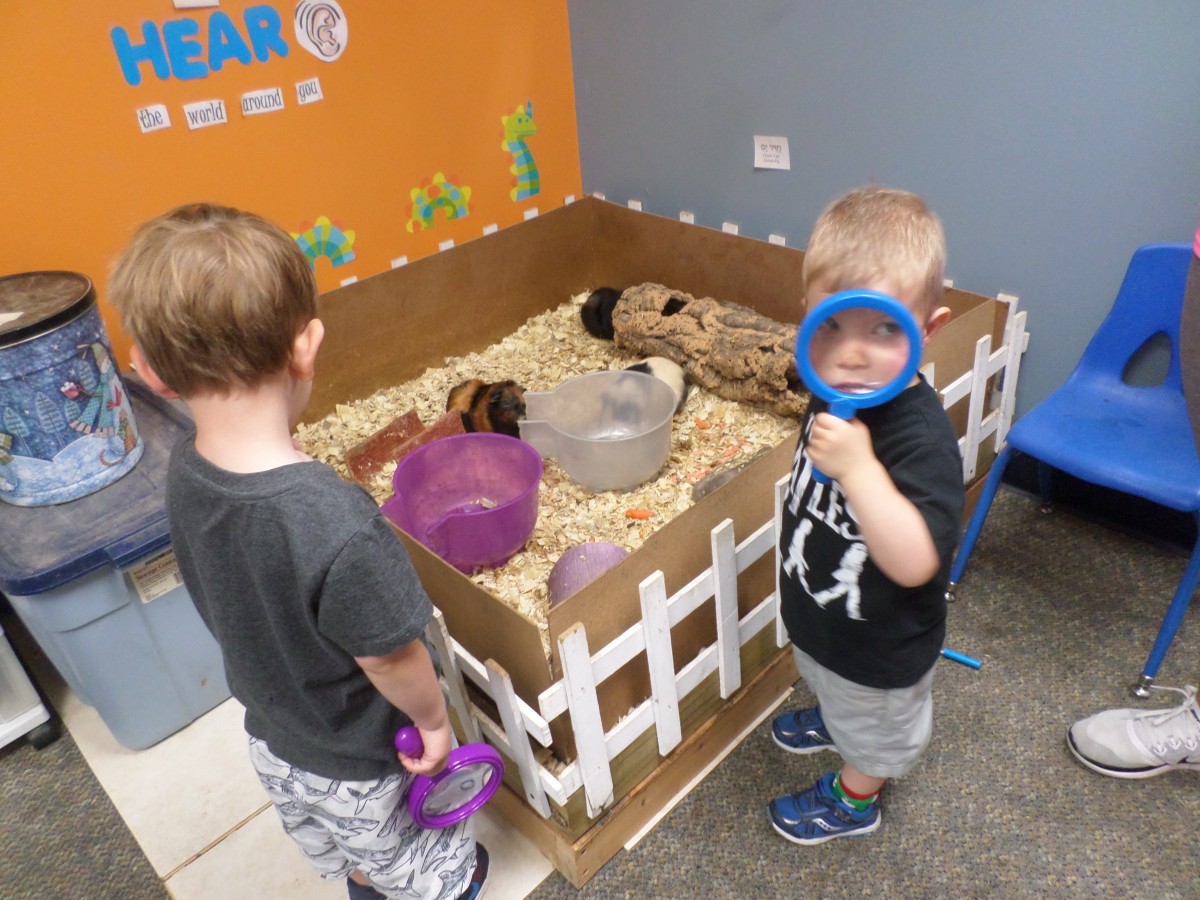Four Guinea Pigs; a Sugar Glider, Parakeet, Tarantula, Blue-Tongued Skink, Dwarf Hamster; and Madagascar Hissing Cockroaches

This is the resident list of the Exploration Center at the Shirlee Green preschool of Congregation Shaare Emeth in St. Louis, Missouri. It’s another of Karen Lucy’s innovations. On occasion, Millie the pot-bellied pig visits with her friend Ruthie, also a pig. A skittish hedgehog is slowly being socialized for eventual residency.
The hedgehog was in Karen’s office during our phone interview. A father of two active young boys had bought the shy animal a few weeks before. The hedgehog and the boys didn’t mix well, so Karen got the frightened animal. He’d spent his first few days rolled up in a corner hissing. Yet within a few weeks it had started sitting in Karen’s lap, and walking across her desk. She predicted that it could be socialized into the Exploration Center by the fall.
We often think of most preschoolers as impulsive or impatient. These are the years to begin laying the foundations for developing social skills and self-regulation. Children at this age are often impatient. Yes, they are often impatient to learn about everything around them. Yet, as we’ve learned from accounts of behavior in Nature Explore Classrooms, nature has a calming influence on many children. “Problems in self-regulation” seen indoors often dissipate in the outdoor classroom. At Shirlee Green, as in many other schools, time in the outdoor classroom is used to calm children. And as we’ve seen in many preschool Nature Explore Classrooms (the Fourth Street Early Learning Center in East Los Angeles, for one) children have an inborn empathy, and can develop social skills naturally—in the right environment. Karen uses nature and animals to facilitate children’s innate, emergent social and self-regulation skills.
And the shy hedgehog in Karen’s office is a great teaching partner for this learning. Like flowers or vegetables, this hedgehog can teach the patience needed to engage with slow, long-term change and growth. Of course only a few children can visit him at a time. And they have to be as gentle as possible. And they’ll have to wait a long, long time before he can live in the Exploration Center. Again, the fingerprints of Mindful Teaching and intentionality are all over this learning experience. “Patience is such a hard virtue nowadays to teach,” she says, “but the animals offer that message to them so much easier.”
When the children’s guide for these experiences is someone who knows animals as deeply as she does children, the dimensions of learning expand exponentially. As Karen told me, while children are developing socialization skills from their interactions with the animals, the animals themselves are also learning these lessons from the children. The two-way socialization learning the children are having with the hedgehog is an endearing example of Mindful Teaching.
Karen told me that animals at Shirlee Green offer tolerance, acceptance, and dependability, and lessons in responsibility and nutrition.
Nutrition?
She told a charming story of how the animals taught children about nutrition. When she opened the Exploration Center the children asked if they could feed the animals. They saved up their extra snack food for a few days, but were troubled when told that animals don’t eat processed cheese and fruit snacks. ‘What do they eat?’ asked the children. “Let’s find out,” said Karen. She went down the list of animals describing the vegetables and fruits they eat. “I had phone calls from my parents asking, “Why are my kids asking for fruits and vegetables?”
Karen noted that the animals communicate to the children when they open the door to the Exploration Center. The sugar glider comes out of his pouch. The guinea pig moves to the edge of his cage and speaks. The animals are socialized to the children.
While other children might think of guinea pig sounds as just sounds, children at Shirlee Green have studied their various vocalizations. Wheeking, chutting, purring and rumbling are just some of these sounds the children study via the internet. This helps them better understand what the guinea pigs are communicating to them.
We cherish and understand (or think we understand) the many looks and behaviors of our beloved pets, especially our dogs. But we rarely take the time to see that other animals are communicating with us, as well. The children at Shirlee Green will see that their mindful and nurturing behaviors will influence the hedgehog. He will learn that they are not a threat. His behaviors toward them will change. As they learn about the hedgehog, children will be learning about themselves, and about each other. The hedgehog will be increasingly socialized towards the children, and eventually to the other animals in the Exploration Center. In Karen’s world of Mindful Teaching, we’re all in it together.
When we see animals and nature with mindfulness and act with intentionality, we see the full world around us more clearly. When we see with open eyes, hear with open ears, and feel with an open heart, we access this world. It’s the world as Karen understands it; the world of nature she shares with her very fortunate students.
I think they’re on to something.

